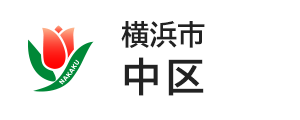- 橫濱市首頁
- 中區首頁
- 各種各樣的語言(Multilingual)
- English
- Public Relations Magazines
- Koho Yokohama Naka Ward Version(~2023)
- 2021
- May ①We are all residents of Naka Ward, Yokohama’s multicultural community! ②“Yokohama Commemorative Monuments in Naka Ward: A Guide Map” ③Wasp and hornet nests
從這裡開始是正文
May ①We are all residents of Naka Ward, Yokohama’s multicultural community! ②“Yokohama Commemorative Monuments in Naka Ward: A Guide Map” ③Wasp and hornet nests
This is an abridged version of “Koho Yokohama Naka-ku Ban,” Naka Ward Office’s public relations magazine. (Click here for the multilingual website of “Koho Yokohama City Edition”)
Last updated date:2024/10/10
① We are all residents of Naka Ward, Yokohama’s multicultural community! Start of the Second Term Naka Ward Multicultural Coexistence Promotion Action Plan!
Inquiries : Kikaku Chosei-gakari (Planning and Adjustment Section), Naka Ward Office
Tel: 224-8127 Fax: 224-8214
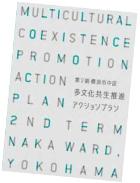
Naka Ward has been promoting measures to encourage multicultural coexistence with the aim of creating a community where everyone can live in peace of mind, regardless of their nationality or roots.
Based on the results of our past efforts, we formulated the second term of our Action Plan in March this year, and have since launched a series of new initiatives under this plan.
Data on Naka Ward’s multicultural community
Number of countries and regions of origin: 93! Naka Ward is clearly becoming an increasingly multinational community.
Number of non-Japanese residents and rate of increase by country/region
(Top 8 countries, compared to 10 years ago)

*From City of Yokohama Statistics Information Portal
Non-Japanese residents of Naka Ward having been living here for various lengths of time, from permanent residents to short-term residents.
Percentage of non-Japanese residents by length of stay
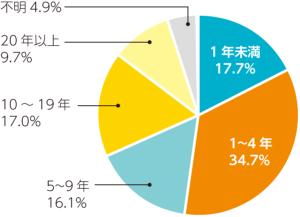
不滿1年: Under 1 year
1~4年: 1 to 4 years
5~9年: 5 to 9 years
10-19年: 10 to 19 years
20多年: 20 years or more
不明: Unknown
*From the Basic Survey on the Number of Non-Japanese Residents in Naka Ward (Fiscal Year 2019)
As you can see, non-Japanese residents of Naka Ward have a wide variety of nationalities and have been living here for various lengths of time.
The Action Plan will provide support tailored to their particular lifestyles and needs.
What people are saying about multiculturalism
We asked non-Japanese residents about their interactions with Japanese residents and community involvement.
*From the Naka Ward Opinion Poll of Non-Japanese Residents (Fiscal Year 2020)

“I would like to have more chances to interact with Japanese people to share home cooking from our countries and to try the tea ceremony.”

“I don't know anything about neighborhood associations and have never been invited to join one, but I would love to get involved in the community through volunteer work.”

I don't know what’s going on or where, or even if it’s okay for me to join in. It's not so easy just to suddenly show up somewhere if you don't know anyone there.”
As you can see, many non-Japanese residents want to have more interaction with Japanese people in the community, such as through local activities.
The Action Plan aims to create a community where non-Japanese residents feel welcome to get involved.
Aims of the Second Term Naka Ward Multicultural Coexistence Promotion Action Plan
Vision
“We are all residents of Naka Ward, Yokohama’s multicultural community”
- Together, we will take the future of Naka Ward into our hands and create a community filled with vitality -
Key points
In addition to further enhancing our past efforts, we will focus on building ties with the community.
Pillar 1: Deepening knowledge and understanding
We will provide the necessary information to non-Japanese residents and visitors to Naka Ward, and further deepen understanding of multicultural coexistence among both Japanese and non-Japanese residents.

Provision of counter services in various languages
Pillar 2: Interaction and mutual help
We will increase interest among non-Japanese residents in community activities, providing them with more opportunities to work alongside and interact with Japanese residents, and build relationships that allow everyone in the community to help each other out regardless of nationality.
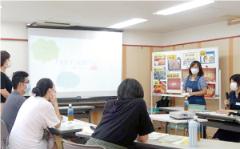
Parenting class for non-Japanese residents
Pillar 3: Connect and broaden horizons
We aim to create a society in which all residents, regardless of nationality or roots, can work together to solve problems as equal members of a united Naka Ward, and as leaders who support the community.
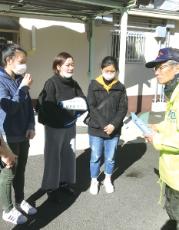
Promotion of community participation among non-Japanese residents by multicultural community coordinators at Naka International Lounge*
* Naka International Lounge
A support center for non-Japanese residents located on the first floor of Naka Ward Office Annex. It is the hub for multicultural activities in Naka Ward, providing such services as information on daily life in various languages, Japanese language classes, study support classes, and the dispatch of multilingual volunteers.
Based on this plan, we will aim to become a multicultural community where all residents, regardless of nationality, can be who they are, recognize each other, and play an active role together as equal members of a united Naka Ward.
② “Yokohama Commemorative Monuments in Naka Ward: A Guide Map” has been updated!
Inquiries : Kikaku Chosei-gakari (Planning and Adjustment Section), Naka Ward Office
Tel: 224-8127 Fax: 224-8214

Naka Ward, where Yokohama Port opened to the world, is dotted with numerous monuments that commemorate the beginnings of Yokohama as we know it today and other “firsts in Japan”, and which tell us about the history behind the port’s opening. “Commemorative Monuments in Naka Ward: A Guide Map” is a walking map of the city that introduces these fascinating monuments.
New guide map! “Commemorative Monuments in Naka Ward Special Edition: Sports that Arrived in Japan from the West”

Naka Ward is the place where many sports were introduced to Japan from the West. This special edition provides an easy-to-understand introduction to the history of this influx of sports.
【Where to get a copy】
General Information Counter on the 1st floor of Naka Ward Office, Kusei Suishin-ka (Ward Administration Promotion Division) (Counter 63 on the 6th floor), or the website
③ Wasp and hornet nests: early detection = early removal!
Inquiries : Kankyo Eisei-gakari (Environmental Sanitation Section), Naka Ward Office
Tel: 224-8339 Fax: 681-9323
Spring through fall is the time of year when wasps and hornets become more active, when their nests grow larger. Hornets and paper wasps are beneficial insects that eat caterpillars and other insects, but they can be dangerous if they nest near your home. Check the area around your house to see if there are any wasp or hornet nests.
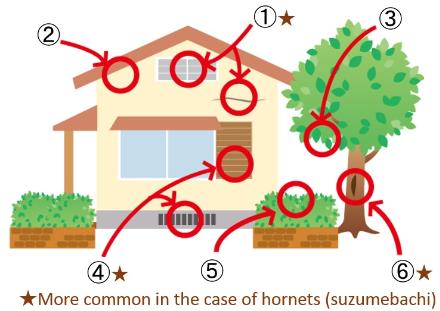
Wasps and hornets tend to build their nests in the following kinds of places!
① In ceilings and walls
② Under eaves
③ On tree branches
④ Under floors or in sliding door fixtures
⑤ In hedges and shrubbery
⑥ In tree hollows
If you find a wasp or hornet nest
・Move away quietly so as not to irritate the wasps or hornets.
・Depending on the type and size of wasps or hornets (e.g. in the case of small nests in the early stages), you may be able to get rid of the nest by yourself.
・The Kankyo Eisei-gakari (Environmental Sanitation Section) will explain how to get rid of them and lend you protective clothing. If you are unable to remove the nest by yourself, you can contact a professional exterminator (for a fee).
・If you find a hornet (suzumebachi) nest, you are recommended to ask an exterminator.
Hornet (suzumebachi) nest (single hole in one location)
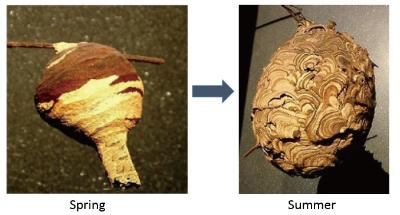
Paper wasp (ashinagabachi) nest (many holes at the bottom)

頁面ID:185-994-026
